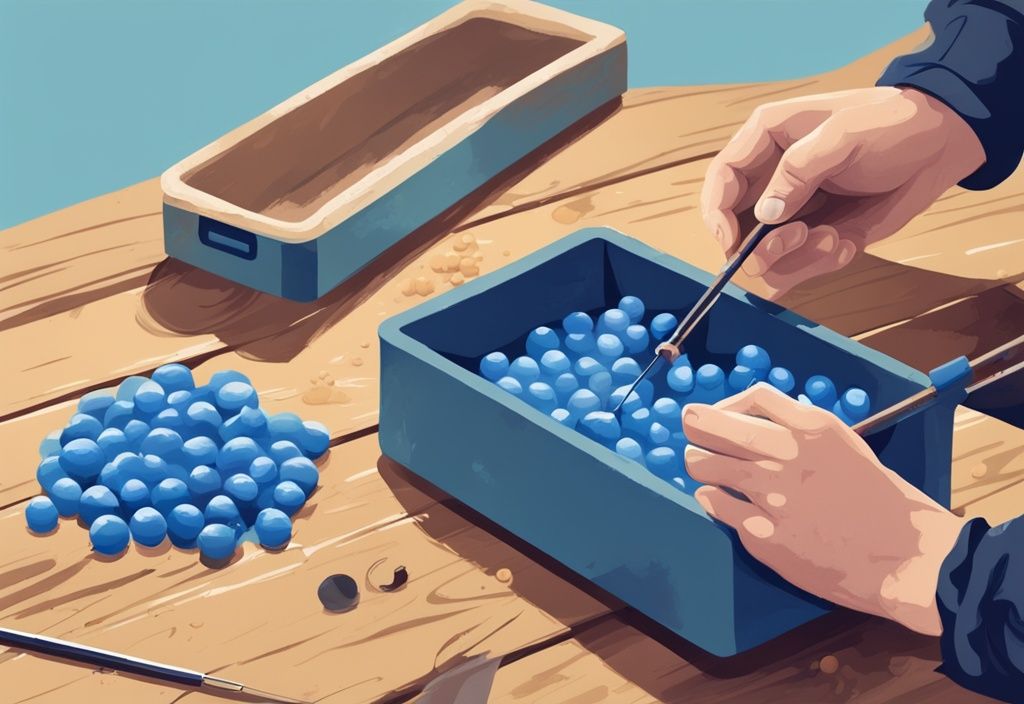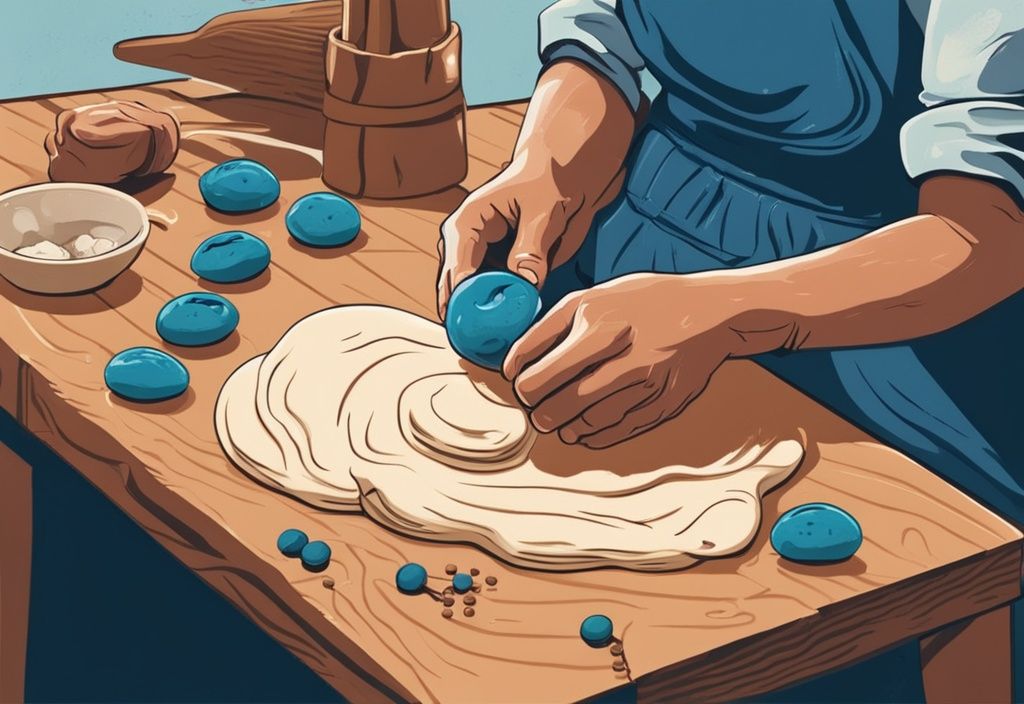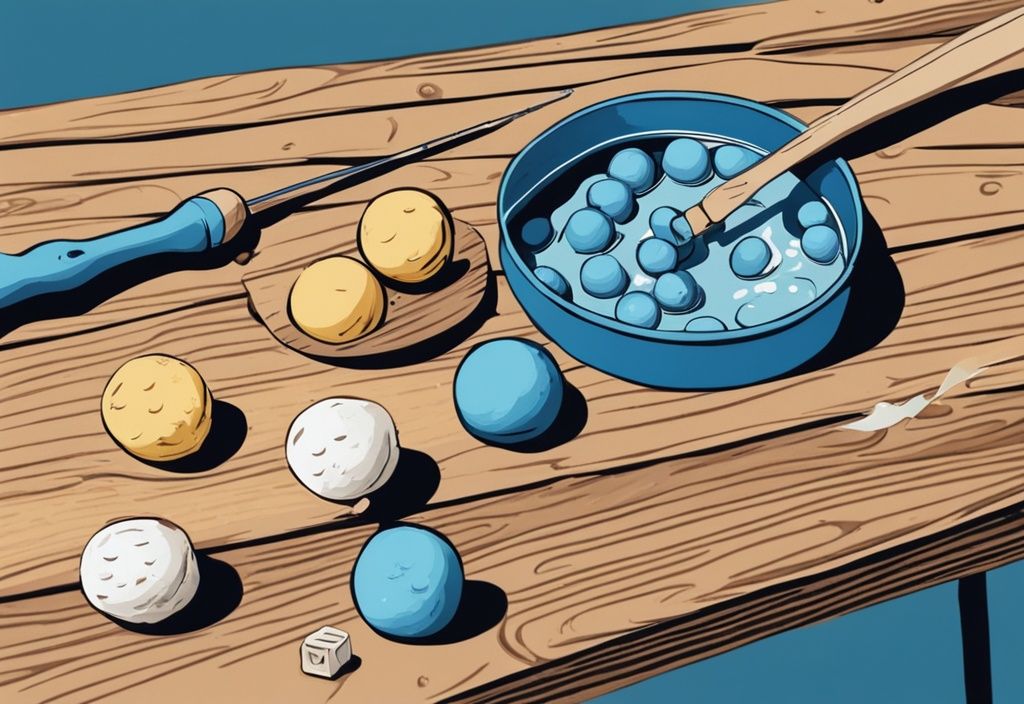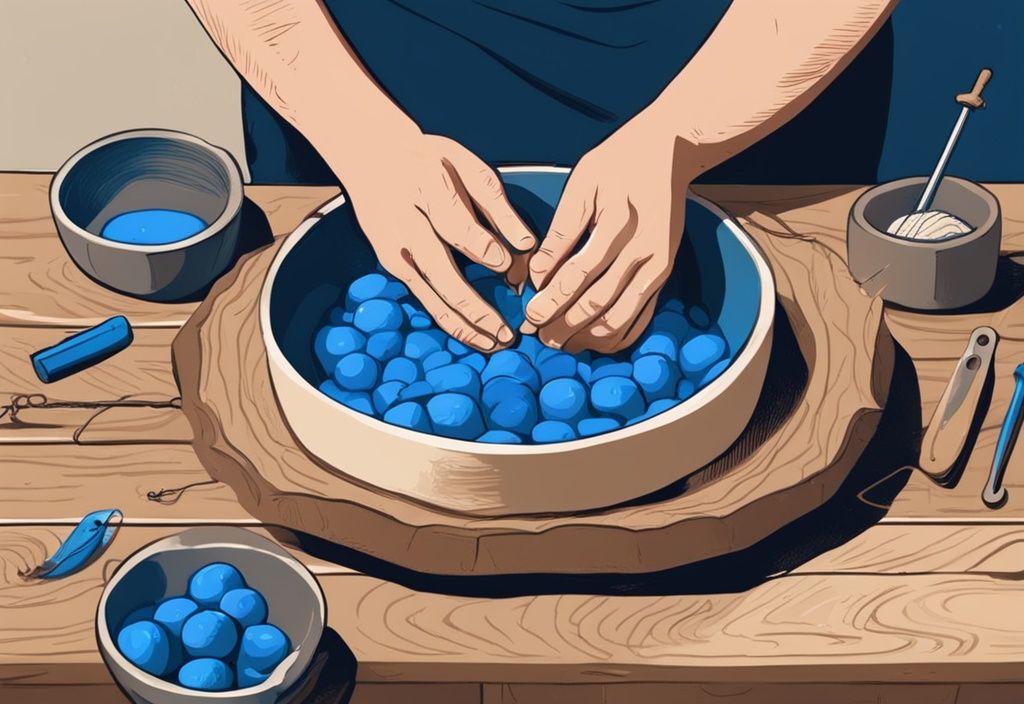Do you want to catch more fish and save some cash doing it? I’m Jake Marlin, your handy angling companion, and I’m about to spill a secret that’s been in my tackle box for years: homemade dough balls. A tried and true bait that has had sunfish, catfish, and even some stubborn saltwater panfish biting like crazy.
We’re lucky because the trick for making these irresistible dough balls lies in easy-to-find household items. And guess what? These homemade marvels often outfish those pricey baits we see in stores. In this guide, you’ll get step-by-step instructions on how to whip up your batch in no time.
Whether a beginner or a seasoned angler, switch up your fishing game with this little-known secret to baiting fish. You’re in for a rewarding and cost-effective fishing experience. Happy casting, folks!
Ingredients You Will Need for Homemade Dough Balls
Basics for Your Dough Balls
Learning how to make dough balls for fishing starts with gathering the essential ingredients. The basic components you’ll need include flour, cornmeal, breakfast cereals, or breadcrumbs, and water. These ingredients form the foundational mix that attracts a variety of fish species.
The typical ratio for creating effective dough balls is balancing one part flour with one part cornmeal or breadcrumbs. Start by mixing these dry ingredients together, ensuring they are well-blended. Gradually add enough water to form a sticky dough, which is essential for sticking to the hook and enticing fish.
To elevate your dough balls and enhance their effectiveness, consider incorporating optional ingredients. Things like garlic, vanilla extract, cheese, anise, or even food coloring can significantly improve your bait’s scent and visual appeal. Garlic and anise are particularly potent for attracting fish due to their strong scents. Vanilla extract and cheese can add a rich aroma and flavor to the mix, increasing its attractiveness.
By following these guidelines, you’ll be well on your way to making irresistible dough balls that can help you catch more fish during your fishing adventures.
A Beginner’s Step-by-Step Guide to Making Dough Balls for Fishing
Making dough balls for fishing is an essential skill that every angler, whether a novice or a pro, should master. This guide will walk you through the process, ensuring your bait is irresistible to fish. Let’s dive into the details!
Mixing Dry Ingredients
Combining the dry ingredients is the foundational step in how to make dough balls for fishing. Begin by adding equal parts of flour, cornmeal, or breadcrumbs into a large mixing bowl. Each of these components plays a crucial role. Flour provides the base, cornmeal adds texture, and breadcrumbs offer an appealing consistency to various fish. If you’re interested in enhancing your fishing experience, you might want to explore the best 5 saltwater spinning reels to complement your culinary endeavors. To enrich the mixture further, consider incorporating additional elements like rolled oats, glitter, or bran cereals such as Wheaties. These additives increase the dough’s attractiveness and strengthen its texture.
Forming Dough with Water
Achieving the right consistency is essential in how to make dough balls for fishing. Gradually add water to the dry mixture while constantly stirring. It’s important to balance the water quantity with the dry ingredients to form a consistent, sticky dough. Avoid adding too much water, as this can make the dough overly wet and difficult to handle. The goal is a sticky but manageable dough that will effectively hold onto the hook and attract fish.
Shaping Your Dough into Perfect Balls
Once the dough achieves the right consistency, shape it into small, bite-sized balls. The size of the dough balls can be tailored to the type of fish you’re targeting. For panfish, creating pea-sized balls works best. If you’re aiming for bullheads or catfish, marble-sized balls are ideal. For larger, deepwater fish, egg yolk-sized balls are most effective. Ensure each dough ball is compact and smooth, which helps it stay firmly on the hook during fishing. This attention to detail in shaping is crucial when learning how to make dough balls for fishing efficiently.
By following these steps, you’ll master the process of creating bait that entices fish and remains durable in the water. Keep practicing, and soon you’ll find the perfect formula that works best for your fishing needs.
Insider Tips for Making Perfect Dough Balls
If you’ve ever wondered how to make dough balls for fishing that get the job done, you’re in the right spot. Below are some tried-and-true tips to help you nail it every time.
Checking Consistency: The Key to Success
Achieving the right consistency is crucial when learning how to make dough balls for fishing. To prevent your dough from becoming overly sticky, incorporate ingredients like flour, sand, or oatmeal. This helps balance the moisture and ensures the dough maintains a workable texture.
Ideally, the dough should be firm enough to stay securely on the hook but soft enough to appeal to fish. Striking this balance can significantly increase your chances of a successful fishing trip. Ever had a dough ball slip off right as you were about to reel in a big one? Yeah, me too. Consistency is the secret sauce.

Determining the Ideal Size for Your Dough Balls
The size of your dough balls should vary depending on the target fish species. For example, smaller, pea-sized dough balls are more suitable for panfish, while marble-sized ones are better for bullheads and catfish.
For deepwater fishing, larger, egg yolk-sized dough balls are often more effective. Experimenting with different sizes can help you determine what works best for the specific fish you’re targeting. This versatility is key in mastering how to make dough balls for fishing. I remember switching the size up one summer afternoon, and voila! Suddenly, the fish were biting like I’d dipped the bait in magic.
Prevent Dough Balls from Falling Off: Secrets of Firmness
Maintaining the firmness of your dough balls is essential to ensure they remain on the hook during your fishing expedition. One effective method is to boil the dough balls for one minute, which helps them become more durable and less likely to disintegrate in the water.
Additionally, rotating the dough balls during boiling ensures they retain their shape and firmness. These tips are invaluable for anglers seeking to optimize their bait durability and effectiveness. Imagine you’ve got your favorite spot by the lake, the sun setting just right, and your perfect dough ball slips off—your fishing day takes a nosedive. Trust me, these firmness secrets are your best friends out there.
Supercharging Your Dough Balls for Fishing, The Game-Changer
Understanding how to make dough balls for fishing can transform your fishing adventures, especially when you amp them up with specific additives. Each additive brings unique benefits, turning your dough balls into irresistible bait. Here’s how you can make a good thing even better.
Common Additives and Their Benefits
One of the keys to mastering how to make dough balls for fishing is to integrate powerful additives that enhance their appeal. Adding ingredients like garlic, cheese, and anise can elevate your bait to a whole new level. These additives turn ordinary dough balls into a fish’s favorite meal.
The Power of Garlic
Ah, garlic—universally loved in kitchens and absolutely magic in dough balls. Whether it’s raw garlic, powdered, or garlic salt, this potent additive can work wonders. The strong aroma acts like a beacon, attracting fish from distances. The scent of garlic makes your bait almost impossible for fish to resist.
Cheese: A Secret Ingredient
Cheese offers a distinct scent and flavor, transforming your dough balls into irresistible treats. Incorporate small amounts of cheese to add richness and a unique scent profile. This bait is particularly effective for fish that prefer richer flavors, enhancing the allure of your dough balls.
Anise: An Unlikely Hero
Surprise, surprise—anise is a game-changer. The licorice-like aroma can appeal to a variety of fish species. Adding anise to your dough balls creates a unique scent profile that stands out in waters teeming with traditional baits. Trust me; it’s a hidden gem in bait-making.
Tricks to Boost Scent & Attract more Fish
Mastering how to make dough balls for fishing involves more than just ingredients. Enhancing the scent of your dough balls can drastically boost your success rate. Let’s dive into some scent-boosting tricks that work like magic.
First off, incorporating smelly substances like chicken fat into your boiling water can work wonders. This infusion gives the dough balls a rich, far-reaching aroma, drawing fish from greater distances.
Another nifty trick is to blend flavored drink mixes, such as strawberry or cherry, into your dough. The vibrant scents and enticing colors make the dough balls visually and aromatically appealing. These fruity mixes mask the dough’s natural scent and lure fish with their intriguing aroma. Don’t be afraid to experiment—finding the right combination can lead to surprisingly effective results.
Custom Dough Ball Recipes for Different Kinds of Fish
Sometimes the difference between a good fishing day and a great one is the bait you use. Let’s dive into some dough ball recipes that cater to the taste of different fish species, drawing from over two decades of angling adventures.
Sunfish and Panfish? We Got This!
Sunfish and panfish are often drawn to simple but effective baits. To make dough balls for these species, begin with fresh white sandwich bread as your base. Tear the bread into small pieces and mix in a bit of water until you can form a firm ball that will stay secure around the hook.
For added attraction, incorporate a hint of sweetness or vanilla extract. The subtle scent can entice these fish, making your bait irresistible. Picture this: the fresh scent wafts through the water, intriguing sunfish and panfish to investigate your bait.
Formula for Fishing Catfish
Catfish are intrigued by strong scents and an interesting mixture of textures in their bait. Combine equal parts of cornmeal and flour as the base of your dough. Add a touch of cotton to help the dough hold its shape in water.
Anise is a key ingredient here; its strong aroma attracts catfish from far and wide. For an extra boost, consider adding canned corn and a bit of pancake syrup. These additions not only enhance the scent but also add a sweet element that catfish can’t resist. Imagine the rush of excitement when that catfish bites onto your uniquely aromatic bait.
Hooking Saltwater Fish: The Special Mix
Saltwater fish can be more particular, requiring a unique blend to catch their attention. Crush Wheaties and mix with soaked bread as the foundational ingredients. To create the right consistency, use Big Red soda instead of water.

The sweetness and bubbles from the soda make the dough more inviting to saltwater fish. For an additional twist, soften koi pellets in boiling water and mix them into your dough. These ingredients come together, forming a dough ball particularly effective for catching various saltwater species. Imagine the thrill of the chase as a saltwater fish zeroes in on your perfect bait mix.
Understanding the unique preferences of different fish species and knowing how to make dough balls for fishing tailored to them, increases your chances of success. Each custom recipe is designed to maximize attraction and ensure your bait stays effective long enough to bring in that big catch. So, next time you’re out, these dough ball recipes just might bring you that trophy fish you’ve always dreamed of.
Master the Art of Dough Ball Durability
Boiling dough balls for one minute significantly enhances their durability and firmness, making them ideal for long fishing sessions. This method, often referred to as “boili balls,” is a technique adapted from British fishing practices. The brief boiling process helps the dough maintain its shape and stay on the hook longer, even in challenging conditions. This technique ensures that the dough balls do not disintegrate in water, providing consistency when casting and reeling.
The Pre-boiling Method Debunked
Let me tell you, the pre-boiling method is a game-changer. Imagine you’re out there, feeling the sun warm your back as you cast your line. You want your dough ball to last, don’t you? Boiling them for just a minute is the secret. This little trick, borrowed from our friends across the pond in Britain, transforms your soft dough into resilient “boili balls,” ensuring you practice sustainable fishing methods that help maintain healthy fish populations for the future. For more information on sustainable fishing, check out this resource from National Geographic: Sustainable fishing.
Picture this: your dough ball clinging to your hook, firm and steady, even as you cast into turbulent waters. They’re not going to dissolve and leave you hanging. This pre-boil technique ensures your bait remains intact, promising more catches during those long, serene hours by the water. It’s like giving your bait a little armor, so when the big one hits, you’re ready.
All About Binding Agents: Flour vs. Oatmeal
Choosing the right binding agent for your dough balls can feel like selecting the perfect lure. Each option offers its unique twist.
Flour gives your dough balls a smooth, cohesive texture that’s easy to mold. It’s like sculpting little works of art between your fingers. Flour has excellent binding properties, making it a go-to for many, especially when learning how to make dough balls for fishing.
Now, let’s throw oatmeal into the mix. Picture the grit and grain of oatmeal adding a robust toughness to your dough. This is particularly handy when you’re out there, casting far and hoping to withstand those aggressive fish bites. Combining flour and oatmeal can be a seasoned angler’s secret, allowing you to tweak the firmness of your bait to suit any fishing adventure.
Imagine, with the right mix, your dough balls could endure cast after cast, staying pliable yet durable. It’s the perfect balance, creating a dough that holds its shape yet feels just right for that hungry fish nibbling at your line.
How to Store Your Dough Balls Effectively
Ensuring your dough balls for fishing stay fresh and effective is key to having a successful fishing trip. Here’s how to keep them in tip-top shape, whether you’re planning for a week or months ahead.
Quick Guide to Short-Term Dough Ball Storage
For those just getting the hang of how to make dough balls for fishing, mastering short-term storage is step one. After shaping your dough balls, tuck them into sealed, zip-shut baggies. This simple move keeps air out and freshness in. Pop these baggies into the refrigerator, and your bait is good to go for about a week. It’s like giving your homemade bait a little vacation in the fridge!
The Ins and Outs of Long-Term Dough Ball Storage
Thinking ahead beyond the week? Freezing is your go-to method. After crafting those perfect dough balls, slip them into freezer-safe, zip-shut bags. Make sure they are airtight—no cutting corners here! This way, their texture and effectiveness are preserved indefinitely. A handy tip? Label each bag clearly. That way, you won’t mistake your prized bait for a midnight snack.
Follow these storage tips, and you’ll find that your handmade fishing dough balls remain as reliable as ever. No matter when the fishing bug bites, you’ll be ready with top-notch bait, and who knows? Maybe these small steps will payoff big with your next catch.
Dare to Experiment with Your Dough Ball Recipes
Creating Multiple Variants from a Single Dough Batch
To fully understand how to make dough balls for fishing, embracing experimentation is key. Begin by preparing a single batch of dough using basic ingredients like flour, cornmeal, and breadcrumbs. Once you have a consistent dough, divide it into different sections. This segmentation allows you to create multiple variants by adding a range of ingredients to each portion.
For instance, mix vanilla extract into one section, garlic powder into another, and anise or cheese into the remaining portions. This method provides a way to systematically test which additives are the most effective in attracting various fish species. Don’t hesitate to add different cereals to the dough, like rolled oats or bran cereals such as Wheaties, to vary the texture and increase the dough’s attractiveness. This diversified approach significantly boosts your chances of finding the most successful bait for different fishing conditions.
Evaluating Your Experiments: Tracking Results
Once you have prepared your different dough ball variants, it’s essential to evaluate their performance in real-world conditions. Regularly test each variant on different fishing trips to observe which combinations work best.
Maintain a detailed journal or log to track the success rate of each variant, noting the conditions and types of fish caught. This methodical tracking will help you pinpoint the most effective ingredients and ratios, allowing you to refine your recipes over time.
Document the successes and any adjustments needed for future batches to ensure continuous improvement. This iterative process will enhance your expertise in how to make dough balls for fishing and optimize your bait for maximum effectiveness. Integrating these elements strategically can transform an ordinary fishing trip into a highly successful one, making your angling experience more rewarding and enjoyable.

Attaching Dough Balls to Hooks: The Right Way
One of the most crucial aspects of fishing with dough balls is ensuring they stay on the hook effectively. Let’s dive into some proven methods to keep those enticing dough balls securely attached and ready to lure in the fish.
Nailing the Hair Rig Method
The hair rig method is a refined technique for attaching dough balls to your hooks effectively. Instead of placing the dough directly on the hook, it secures the dough or paste bait onto a loop or hair extending from the hook. This setup not only improves hook-ups but also allows the dough to disperse its scent more freely in the water.
Picture this: you’re out by the lake, the sun just peeking over the horizon. You’ve got your bait needle in hand, ready to thread the dough onto the hair rig. Start by breaking off a piece of your prepared dough and rolling it into a ball suitable for the fish you’re targeting. Gently insert the bait needle through the dough ball, ensuring it passes straight through the center.
Once the dough ball is neatly threaded, slide it down onto the hair loop. Hold onto that excitement because now comes the critical part: securing the dough ball on the hair with a bait stop. This handy little stopper ensures that your dough stays put, even when those crafty fish nibble away.
Traditional Attachment for Combined Effectiveness
Sometimes, the classic methods are classics for good reason. The traditional approach to attaching dough balls involves molding the dough directly around the hook. Simple, right?
Imagine taking a small piece of dough, feeling its pliability in your hands as you roll it into a ball of the desired size. Next, gently press the dough ball onto the hook, ensuring it covers well and is tightly compacted. A little tip from my years on the water: consider using dough from Pillsbury crescent rolls. It’s incredibly pliable and molds easily around the hook.
After molding the dough onto the hook, a quick dip in water helps it to harden slightly. This step is crucial as it makes the dough more durable, reducing the chances of it falling off during casting or when submerged. Think of it as giving your dough an extra layer of staying power.
By following these methods, you’ll master the art of making dough balls for fishing and ensure they stay on the hook. Get ready to feel that familiar tug and the thrill of a successful catch. Tight lines, my friend!
Heading:
Overcoming Environmental Challenges
When you’re knee-deep in the art of making dough balls for fishing, the environment around you can throw some curveballs. From shifting water temperatures to the peculiar tastes of local fish species, adapting is key.
Dealing with Water Temperature
Here’s a nugget of wisdom from my two decades on the water: understanding water temperature is a game-changer. Imagine you’re out on a crisp morning, rod in hand, and your dough balls are breaking apart the second they hit the cold water. Frustrating, right?
Cold water can make your dough stiff and brittle. So, to keep your bait in one piece, mix up a slightly firmer dough by juggling the water content and tossing in a bit more flour or breadcrumbs. Think of it like adjusting a recipe—just enough to get it right.
Now, flip the coin to a warm summer day. The sun’s blazing, and the water’s warm enough for a swim. A softer dough might melt away before a fish even gets a nibble. To tackle this, bolster your mix with binding agents like cornmeal or oatmeal, ensuring the dough stays together. It’s all about feeling the consistency and tweaking as you go. Remember, fish don’t take kindly to a snack that falls apart!
Adapting to Local Fish Species Preferences
If you want to entice those local fish, you’ve got to serve up what they’re hungry for. It’s all about playing to your audience. Start by scoping out what fish are common in your fishing spot and what they typically munch on. This isn’t just about tossing in random flavors—it’s about crafting the perfect bait.
For instance, panfish might have a sweet tooth for vanilla extract or cheese. On days when you’re targeting catfish, stronger scents like garlic or anise are your ticket. Mix and match, see what sticks. It’s like being a chef, but for fish! The right blend can turn a quiet day into a flurry of bites.
As you mix your dough balls, always keep the habits and preferences of the local fish in mind. It’s this thoughtful approach that’ll make your bait irresistible, boosting your chances of a good catch. So, always be prepared to tweak and adapt, and soon enough, you’ll see that big smile on your face as you reel them in.
Happy fishing, fellow angler!
FAQ
Curated Answers for Your Dough Ball Related Queries
What is the Ideal Flour for Fishing Dough Balls?
All-purpose flour is your go-to option for making fishing dough balls. Its smooth texture and excellent binding properties make for effective, reliable bait that stays intact on your hook.
The Correct Duration for Boiling Your Dough Balls: A Guide
Boil your dough balls for around one minute. This brief boiling time balances firmness and attractiveness, helping the dough balls stay together while still enticing fish.
Alternative to Homemade Dough: Store-Bought Bread Ventures
Fresh white sandwich bread and Pillsbury crescent roll dough are superb time-savers. They wrap snugly around the hook and are convenient for those spontaneous fishing trips.
Avoid the Stickiness: Tips on Preventing Overly Sticky Dough Balls
Troubled by sticky dough balls? Add extra flour, sand, or oatmeal to the mix. These ingredients help you achieve that perfect, non-sticky dough consistency, ensuring your bait performs well in the water.
Unveiling the Most Effective Scents to Attract More Fish
Garlic, anise, molasses, and flavored drink mixes like strawberry and cherry can work wonders on your catch rate. These scents amp up your dough ball’s allure, making it irresistible to fish.


